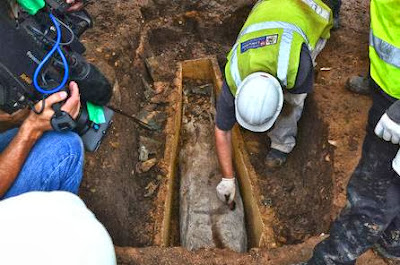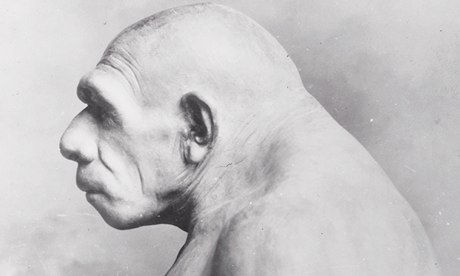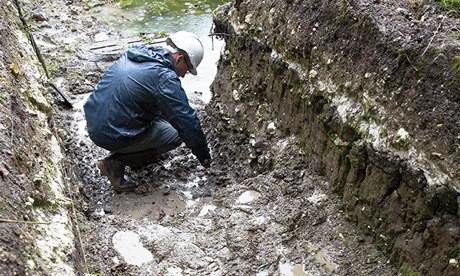Sunday, October 27, 2013
'Roman child's coffin' found in Leicestershire
A child's coffin believed to date back to the 3rd Century AD has been found beneath a Leicestershire field by metal detectorists.
The Digging Up The Past club found the lead coffin and Roman coins at a farm in the west of the county.
Club spokesman David Hutchings said: "I knew it was something a bit special as soon as I saw it."
Read the rest of this article...
Sunday, October 20, 2013
Navenby dig: Another building found at Roman site
The stomach-turning truth about what the Neanderthals ate?
The idea of these early humans being plant-eating, self-medicating sophisticates has been brought into question by the findings of researchers at London's Natural History Museum.
Remains of York's 'lost' St John's church revealed
Pre-Viking Age Monuments Unearthed Near Burial Ground In Sweden
More on lead coffin found at Greyfriars dig
The mysterious lead coffin found yards from the grave of Richard III has delivered another twist in the tale of the Greyfriars excavation.
 |
| Archaeologists expose the lead casket found inside a stone coffin at Greyfriars [Credit: This is Leicestershire] |
The University of Leicester team – which uncovered Richard III a year earlier – also identified two other potential candidates, in Peter Swynsfeld, who died in 1272, and William of Nottingham, who died in 1330 – both former leaders of the Franciscan friars.
Read the rest of this article...
Jersey's place in Neanderthal history revealed in study
Italy's fantastical farmers' sheds turned holiday homes
Silk Road jewel reveals more of its treasures
Saturday, October 19, 2013
Uppsala unearths pagan road of old kings
Archaeologists digging in old Uppsala have discovered what appears to be a remarkable display of power of a fifth century Swedish chieftain. Massive posts marked the ancient road in perfect alignment for more than a kilometre.
"It's exciting because we’ve never seen anything like it in these parts before," Robin Lucas, archaeologist at Uppland Museum, told The Local.
The archaeologists, who were excavating the area in preparation for a new railroad line, discovered 144 post-holes two metres wide and a metre deep in a perfectly straight line spanning a kilometre in Old Uppsala. The post holes are placed precisely six metres from each other.
"It appears to be a processional road leading to Old Uppsala, which was the seat of the early Swedish kings," Lucas said.
Read the rest of this article...
Roman villa found near Devizes
Neanderthals used toothpicks to alleviate gum disease
Removing food scraps trapped between the teeth one of the most common functions of using toothpicks, thus contributing to our oral hygiene. This habit is documented in the genus Homo, as early as Homo habilis, a species that lived between 1.9 and 1.6 million years ago.
New research based on the Cova Foradà Neanderthal fossil shows that this hominid also used toothpicks to mitigate pain caused by oral diseases such as inflammation of the gums (periodontal disease). It is the oldest documented case of palliative treatment of dental disease done with this tool.
This research is based on toothpicking marks on the Neanderthal teeth related to periodontal disease. The chronology of the fossil is not clear, but the fossil remains were associated with a Neanderthal Mousterian lithic industry (about 150,000 to 50,000 years).
Read the rest of this article...
Pre-Viking Age monuments uncovered in Sweden
Archaeologists in Sweden said Thursday they have unearthed the remains of unusually large wooden monuments near a pre-Viking Age burial ground.
 |
| Archaeologists in Sweden have uncovered this 1km-long row of wooden poles which is believed to be from the 5th Century, but their purpose is unclear [Credit: flygfoto] |
Archaeologist Lena Beronius-Jorpeland said the colonnades were likely from the 5th century but their purpose is unclear. She called it Sweden's largest Iron Age construction and said the geometrical structure is unique.
Read the rest of this article...
Finding, studying and sharing the ‘treasure’ beneath our feet
Friday, October 18, 2013
International Archaeology Day
International Archaeology Day is a celebration of archaeology and the thrill of discovery. Every October the AIA and archaeological organizations across the United States, Canada, and abroad present archaeological programs and activities for people of all ages and interests. Whether it is a family-friendly archaeology fair, a guided tour of a local archaeological site, a simulated dig, a lecture or a classroom visit from an archaeologist, the interactive, hands-on International Archaeology Day programs provide the chance to indulge your inner Indiana Jones.
Visit the site...
Slave Tunnels Found Under Hadrian’s Villa
Amateur cavers have discovered a network of tunnels underneath the Villa Adriana (Hadrian’s Villa) at Tivoli, near Rome.
Experts suggest that the subterranean world of tunnels and roads was used to house slaves, oxen, carts and food supplies. The network includes streets wide enough to allow for the passage of carts in both directions as well as narrow passageways. Hadrian’s Villa covers approximately 618 acres but the extent of the underground network is not known yet and excavations are ongoing.
The Roman Emperor Hadrian built the villa as a summer retreat between 38 AD and 118 AD. After his death in 138 AD, his successors used and enlarged the complex. A decade ago, experts realised that there were tunnels beneath the complex, and a team of Italian archaeo-speleologists led by amateur caver Marco Placidi mapped more than a mile of the vast network this year.
Read the rest of this article...
5200 BC House Discovered in Romania
Recently , we shared with you some recent discoveries in Romania, from various periods. Apparently there is room for more, as the biggest house from the pre-Cucuteni period, 5200-5100 BC was just found in Baia, Suceava. Experts from the Cambridge University support this research, seeking to identify how the grain trade between China and Europe was made at that time.
Read the rest of this article...
Unique pre-Viking Age monuments uncovered at Old Uppsala pagan ceremonial site in Sweden
Reconstruction of ancient Slavic boat in Rugen.
Skull Find Could Change Picture of Early Human Evolutionary History
We may have to change some thinking about early human evolution in a major way, suggests researchers, after studying new fossil finds at the site of Dmanisi in the Republic of Georgia. What has previously been thought to be separate ancient human species - Homo erectus,Homo habilis, Homo rudolfensis, and Homo ergaster, for example, may actually be variations of one and the same species. This is the conclusion of a recent examination of fossil finds uncovered at this, the world's earliest known hominid site outside of Africa.
1.8M-year-old skull gives glimpse of our evolution, suggests early man was single species
Archaeologists rediscover the lost home of the last Neanderthals
Bulgaria archaeologists find ancient wine cellar
A team of archaeologists, headed by Associate Professor Aneliya Bozhkova with the National Archaeological Institute with Museum with the Bulgarian Academy of Science, and Petya Kiyashkina with the Ancient Nesebar Museum, discovered a perfectly preserved cellar with amphorae from the V BC, over the last days of the archaeological excavations in the Bulgarian coastal town of Nesebar, the press office of Nesebar Municipality announced.
The research is organised under a project of the Ancient Nesebar Museum, financed by the Ministry of Culture, with the participation of experts in archaeology.
The ancient amphorae warehouse was dug in deep into the ground along the northern coast of the peninsula, which preserved it from the encroachment of time and the following cultural layers.
Read the rest of this article...
Blow to multiple human species idea
Unlocking the mysteries of Israel's Tel Dor
It's cold. It's silent. It's murky. It's the bottom of the Mediterranean Sea and it's the hangout of choice for students of maritime archaeology, seeking clues to the dawn of modern man. Or in the case of participants on Haifa University’s new English MA in Maritime Civilizations, signs of a harbor at the ancient site of Tel Dor.
 |
| View of Tel Dor [Credit: nexttriptourism] |
Read the rest of this article...
Wednesday, October 16, 2013
A Roman bathhouse still in use after 2,000 years
A VIKING WHITEWASH
Burning slaked lime
Frogs' legs may have been English delicacy 8,000 years before France
Discovery that brings forgotten church back to life
Tuesday, October 15, 2013
Landscape Archeaology: Forty Years on
Lecturer: Trevor Rowley
6pm Friday 6 December 2013
To be held at the Rewley House Lecture Theatre, 1 Wellington Square, Oxford, OX1 2JA
The OUDCE is sponsoring an annual lecture on landscape archaeology in memory of Mick Aston, who sadly died earlier this year. Mick was tutor in local studies in the Department for Continuing Education before moving to Bristol University as Staff Tutor in Archaeology. Earlier he had made a major contribution to the archaeology of Oxfordshire through his work on the Sites and Monuments Record, then based at the City and Count Museum, Woodstock.
In this lecture Trevor will discuss the thinking behind Landscape Archaeology, a book which went on to have a significant impact on the development of field archaeology in Britain.
Download an application form...
Bronze Age Europe – the first Industrial revolution
s part of a larger pan-European study investigating the Bronze Age of Europe, an archaeologist from the University of Gothenburg has provided the first evidence of long distance travel by an individual – probably from southern Sweden – into the territory of the Únětice culture of Silesia.
The doctoral thesis confirms evidence based on bioarchaeological data.
A traveller from Sweden
‘Over 3800 years ago, a young male, possibly born in Skåne, made a journey of over 900 kilometres south, to Wroclaw in Poland”. concludes Dalia Pokutta, author of the thesis. He met his end violently in Wroclaw, killed in the territory of the Úněticean farmers. His remains were discovered in association with two local females, who had been killed at the same time.Read the rest of this article...
Amesbury dig 'could explain' Stonehenge history
The site already boasts the biggest collection of flints and cooked animal bones in north-western Europe.
Read the rest of this article...
UW archaeologists have discovered legion barracks in Bulgaria
The remains indicate that the support structure were large wooden poles, while smaller dowels sustained braid covered with soil. In the last phase, the exterior walls were covered with white plaster. The system of small dowels inside large rooms suggests, according to the researchers, that there could be bunk beds in the corners. There were wooden shelves in the vestibules.
Read the rest of this article...
Iron Age camp unearthed at UK quarry
Archaeologists have unearthed an Iron Age enclosure while excavating land at the edge of a working quarry.
 |
| Archaeologists are excavating land close to Potgate Quarry [Credit: Steve Timms/BBC] |
Dig leader Steve Timms said the site was later brought back into use in the early Roman period as a paddock.
Read the rest of this article...
Forscher enträtseln die Bevölkerungsentwicklung Europas in der Jungsteinzeit
Die bisher umfangreichste und detaillierteste genetische Studie zur Besiedlungsgeschichte Europas während des Neolithikums ergab deutliche Hinweise auf vier wesentliche Migrationsereignisse in der Zeit zwischen dem 6. und 2. Jahrtausend v. Chr. Für die heute in Science veröffentlichte Studie untersuchten Anthropologen aus Mainz und Adelaide in Kooperation mit Archäologen aus Halle (Saale) hunderte DNA-Proben von jungsteinzeitlichen Skelettfunden aus dem Mittelelbe-Saale-Gebiet.
Read the rest of this article...
Friday, October 11, 2013
European origins laid bare by DNA
DNA from ancient skeletons has revealed how a complex patchwork of prehistoric migrations fashioned the modern European gene pool.
The study appears to refute the picture of Europeans as a simple mixture of indigenous hunters and Near Eastern farmers who arrived 7,000 years ago.
The findings by an international team have beenpublished in Science journal.
DNA was analysed from 364 skeletons unearthed in Germany - an important crossroads for prehistoric cultures.
Read the rest of this article...
Link to Oetzi the Iceman found in living Austrians
Austrian scientists have found that 19 Tyrolean men alive today are related to Oetzi the Iceman, whose 5,300-year-old frozen body was found in the Alps.
Their relationship was established through DNA analysis by scientists from the Institute of Legal Medicine at Innsbruck Medical University.
The men have not been told about their connection to Oetzi. The DNA tests were taken from blood donors in Tyrol.
Read the rest of this article...
Monday, October 07, 2013
Shock Bronze Age find 'changes history'
The farm was discovered in the area between Backen and Klabböle in an area known as Klockaråkern and it is thought that the farm was in use for almost 600 years from around 1100 BC.
Read the rest of this article...
Lidar reveals New Forest's hidden secrets
Scrambling through the dense forest undergrowth looking for signs from the past may not sound like your average archaeological expedition.
 |
| The Lidar map shows how another Bronze Age barrow, to the left of the damaged one, has been flattened to make the other larger [Credit: BBC] |
With the help of a technique known as Lidar - a laser beamed from a plane - a detailed 3D map of the terrain underneath the forest canopy has been created.
Read the rest of this article...





























